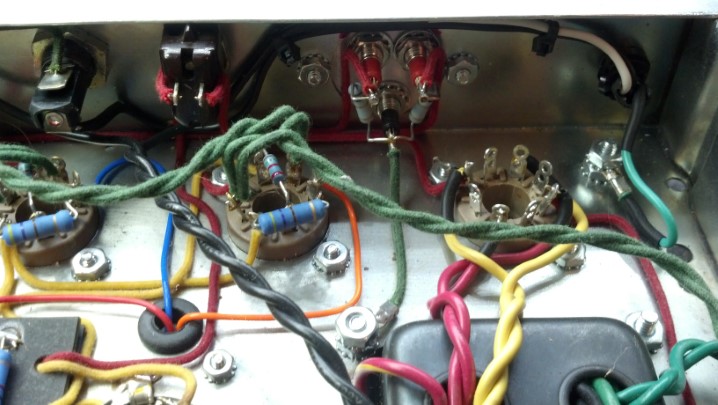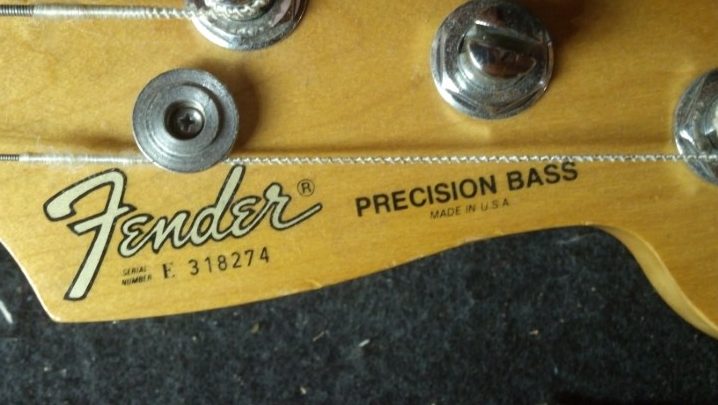Partially submerged in the flood waters of Hurricane Harvey, this combo amp was rescued when the waters receded. Could the Unbrokenstring Crew turn this insurance claim into a working unit again?
 At first glance, this unit is in pretty good shape. Fortunately, the flood waters around this unit were not salty, but fresh rain water. The grille cloth was not badly stained, and much of the exterior grime was superficial.
At first glance, this unit is in pretty good shape. Fortunately, the flood waters around this unit were not salty, but fresh rain water. The grille cloth was not badly stained, and much of the exterior grime was superficial.
 Not much damage had occurred to the cabinet; some warpage was beginning to appear in the bottom baffle. The interior was still wet. This implied that, if the drying-out process could be controlled, no further damage to the cabinet would be sustained.
Not much damage had occurred to the cabinet; some warpage was beginning to appear in the bottom baffle. The interior was still wet. This implied that, if the drying-out process could be controlled, no further damage to the cabinet would be sustained.
 Can you see some rust on the screws?
Can you see some rust on the screws?
 The bottom Tolex has some mildew beginning to form. Look at the rust beginning to form on hardware in the foreground.
The bottom Tolex has some mildew beginning to form. Look at the rust beginning to form on hardware in the foreground.
 The handle was beginning to rust. This could be managed.
The handle was beginning to rust. This could be managed.
 The handle and the Tolex is cleaned and reconditioned with this, which also gives us a clean lemon scent!
The handle and the Tolex is cleaned and reconditioned with this, which also gives us a clean lemon scent!
 This is the top of the reverb tank. Yes, beads of water, still on the exterior of the tank.
This is the top of the reverb tank. Yes, beads of water, still on the exterior of the tank.
 The previous owner had padded the top of the tank with gray foam, and the bottom with cardboard. The cardboard was soaking wet.
The previous owner had padded the top of the tank with gray foam, and the bottom with cardboard. The cardboard was soaking wet.
 Reverb tanks are inexpensive, so we will just order a new one.
Reverb tanks are inexpensive, so we will just order a new one.
 The paper cone of the loudspeaker was intact. This loudspeaker will be replaced by the new owner.
The paper cone of the loudspeaker was intact. This loudspeaker will be replaced by the new owner.
 Moisture inside the amp chassis has swelled the turret board.
Moisture inside the amp chassis has swelled the turret board.
 Water has reacted with the solder flux, creating a brown crust around all the solder joints. The components still look pretty good, although they cannot be trusted now.
Water has reacted with the solder flux, creating a brown crust around all the solder joints. The components still look pretty good, although they cannot be trusted now.
 Corrosion on the tube socket contacts testifies to the presence of liquid water here. Note also that the zinc plating on the once-shiny chassis is turning cloudy. This tells us that the zinc is doing its job as a corrosion-inhibiting plating, sacrificing itself to protect the steel underneath.
Corrosion on the tube socket contacts testifies to the presence of liquid water here. Note also that the zinc plating on the once-shiny chassis is turning cloudy. This tells us that the zinc is doing its job as a corrosion-inhibiting plating, sacrificing itself to protect the steel underneath.
 The cabinet hardware is washed in Rust Biox to clear away the rust. This chemical is available in Europe, but of course, The Unbrokenstring Crew is just cool enough to have this material here in the U.S.
The cabinet hardware is washed in Rust Biox to clear away the rust. This chemical is available in Europe, but of course, The Unbrokenstring Crew is just cool enough to have this material here in the U.S.
 The nickel plating has very little iron to rust; This deposit is probably mud.
The nickel plating has very little iron to rust; This deposit is probably mud.
 All the hardware is cleaned up. The Tolex is cleaned and conditioned with the furniture polish. The cabinet looks good as new!
All the hardware is cleaned up. The Tolex is cleaned and conditioned with the furniture polish. The cabinet looks good as new!
 A new tube chart is pasted inside the cabinet where the original one was located.
A new tube chart is pasted inside the cabinet where the original one was located.
 For the electronics, a hand-wired chassis from the estate of Darrell Shifflett of Texas Amplification is pressed into service. The Unbrokenstring was truly fortunate to buy the remaining inventory of Texas Amplification. This chassis was part of the inventory. Look at those shiny new jacks!
For the electronics, a hand-wired chassis from the estate of Darrell Shifflett of Texas Amplification is pressed into service. The Unbrokenstring was truly fortunate to buy the remaining inventory of Texas Amplification. This chassis was part of the inventory. Look at those shiny new jacks!
 The knobs are, of course correct. This is a clone of a Fender Blackface Princeton Reverb, not built in California but rather in Houston, Texas.
The knobs are, of course correct. This is a clone of a Fender Blackface Princeton Reverb, not built in California but rather in Houston, Texas.
 Darrell was a master of the details. Even the front panel is Correct for this unit.
Darrell was a master of the details. Even the front panel is Correct for this unit.
 As a testament to Darrell, let’s just take a look at his workmanship.
As a testament to Darrell, let’s just take a look at his workmanship.
 The wiring and component placement is meticulous.
The wiring and component placement is meticulous.
 If original components were available, such as the carbon composition resistors, he used them. Modern flame-proof components are used where an improvement in reliability and safety without sacrificing sonic performance justified the upgrade.
If original components were available, such as the carbon composition resistors, he used them. Modern flame-proof components are used where an improvement in reliability and safety without sacrificing sonic performance justified the upgrade.
 Even the wire is period-correct, fabric-covered was used for the point-to-point wiring, just like the originals.
Even the wire is period-correct, fabric-covered was used for the point-to-point wiring, just like the originals.
 A bias check for EACH output tube is added to the rear panel. Millivolts measured from red to black correspond to milliamps of plate current.
A bias check for EACH output tube is added to the rear panel. Millivolts measured from red to black correspond to milliamps of plate current.
 The jacks and controls are name-brand and not the cheap stuff.
The jacks and controls are name-brand and not the cheap stuff.
 But just look at that fresh brass sheet used for the ground plane under the controls. The original brass probably didn’t look this good in Fender units when they were new!
But just look at that fresh brass sheet used for the ground plane under the controls. The original brass probably didn’t look this good in Fender units when they were new!
 The underside of this amp is just a voyage on the Good Ship Eye Candy!
The underside of this amp is just a voyage on the Good Ship Eye Candy!
 The electronic tremolo circuit is duplicated on this turret board. Not sure why this turret board is warped, but it is electrically 100%.
The electronic tremolo circuit is duplicated on this turret board. Not sure why this turret board is warped, but it is electrically 100%.
 Speaking of turret boards, just look at the meticulous care used to mount each component and route the leads. Even the bias potentiometer is nicely placed.
Speaking of turret boards, just look at the meticulous care used to mount each component and route the leads. Even the bias potentiometer is nicely placed.
 Comparing this layout against the original Fender drawings is just breath-taking.
Comparing this layout against the original Fender drawings is just breath-taking.
 I’m really jazzed about how the fabric-covered wire is carefully routed around the tube sockets.
I’m really jazzed about how the fabric-covered wire is carefully routed around the tube sockets.
 We needed a new rectifier tube for this amp.
We needed a new rectifier tube for this amp.
 Darrell used Mercury Magnetics for all the transformers on this chassis… the best you can get!
Darrell used Mercury Magnetics for all the transformers on this chassis… the best you can get!
 With the power on, all the voltages are correct.
With the power on, all the voltages are correct.
 The new reverb tank arrived today.
The new reverb tank arrived today.
 The bag protecting the reverb tank is dry and ready to be used again.
The bag protecting the reverb tank is dry and ready to be used again.
 These straps hold the reverb tank bag in place in the bottom of the amplifier.
These straps hold the reverb tank bag in place in the bottom of the amplifier.
 The ON/OFF switch works as it should. Since the AC cord is a modern three-wire unit, the original ‘GROUND’ switch is wired as a STANDBY/ON switch.
The ON/OFF switch works as it should. Since the AC cord is a modern three-wire unit, the original ‘GROUND’ switch is wired as a STANDBY/ON switch.
 This unit is ready to go back to the new owner, who will install the new loudspeaker. Pretty nice unit for having been under water!
This unit is ready to go back to the new owner, who will install the new loudspeaker. Pretty nice unit for having been under water!
Thanks for reading all the way to the end!
CONTACT – David Latchaw EE
281-636-8626




















































































































































































